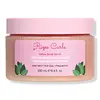What's inside
What's inside
 Key Ingredients
Key Ingredients

 Benefits
Benefits

 Concerns
Concerns

 Ingredients Side-by-side
Ingredients Side-by-side

Water
Skin ConditioningAloe Barbadensis Leaf Juice
Skin ConditioningSodium C14-16 Olefin Sulfonate
CleansingCocamidopropyl Hydroxysultaine
CleansingHydrated Silica
AbrasiveSodium Cocoyl Isethionate
CleansingAcrylates Copolymer
Glycerin
HumectantSodium Gluconate
Skin ConditioningHydroxyacetophenone
AntioxidantGlycol Distearate
EmollientMoringa Oleifera Seed Oil
EmollientSodium Benzoate
MaskingPanthenol
Skin ConditioningArnica Montana Flower Extract
MaskingThymus Vulgaris Flower/Leaf Oil
MaskingMenthyl Lactate
MaskingMentha Piperita Oil
MaskingPelargonium Graveolens Oil
MaskingPhenoxyethanol
PreservativeEthylhexylglycerin
Skin ConditioningPolyquaternium-7
Montmorillonite
AbsorbentIllite
AbrasiveKaolin
AbrasiveCitric Acid
BufferingWater, Aloe Barbadensis Leaf Juice, Sodium C14-16 Olefin Sulfonate, Cocamidopropyl Hydroxysultaine, Hydrated Silica, Sodium Cocoyl Isethionate, Acrylates Copolymer, Glycerin, Sodium Gluconate, Hydroxyacetophenone, Glycol Distearate, Moringa Oleifera Seed Oil, Sodium Benzoate, Panthenol, Arnica Montana Flower Extract, Thymus Vulgaris Flower/Leaf Oil, Menthyl Lactate, Mentha Piperita Oil, Pelargonium Graveolens Oil, Phenoxyethanol, Ethylhexylglycerin, Polyquaternium-7, Montmorillonite, Illite, Kaolin, Citric Acid
Water
Skin ConditioningGlycerin
HumectantSorbitol
HumectantPolysorbate 20
EmulsifyingGlycereth-26
HumectantSodium Polyitaconate
Arginine
MaskingCarbomer
Emulsion StabilisingAloe Barbadensis Leaf Juice
Skin ConditioningTriethyl Citrate
MaskingTocopherol
AntioxidantEquisetum Arvense Extract
AstringentHelianthus Annuus Extract
EmollientHumulus Lupulus Extract
AntimicrobialLinum Usitatissimum Seed Extract
PerfumingMelissa Officinalis Leaf Extract
Skin ConditioningOryza Sativa Bran Extract
Skin ConditioningRosmarinus Officinalis Leaf Extract
AntimicrobialThymus Vulgaris Flower/Leaf Extract
MaskingUlmus Fulva Bark Extract
MoisturisingUrtica Dioica Extract
AstringentAminomethyl Propanol
BufferingEthylhexylglycerin
Skin ConditioningTetrasodium Glutamate Diacetate
Disodium EDTA
Amp-Acrylates Copolymer
Polyurethane-14
Parfum
MaskingPhenoxyethanol
PreservativeWater, Glycerin, Sorbitol, Polysorbate 20, Glycereth-26, Sodium Polyitaconate, Arginine, Carbomer, Aloe Barbadensis Leaf Juice, Triethyl Citrate, Tocopherol, Equisetum Arvense Extract, Helianthus Annuus Extract, Humulus Lupulus Extract, Linum Usitatissimum Seed Extract, Melissa Officinalis Leaf Extract, Oryza Sativa Bran Extract, Rosmarinus Officinalis Leaf Extract, Thymus Vulgaris Flower/Leaf Extract, Ulmus Fulva Bark Extract, Urtica Dioica Extract, Aminomethyl Propanol, Ethylhexylglycerin, Tetrasodium Glutamate Diacetate, Disodium EDTA, Amp-Acrylates Copolymer, Polyurethane-14, Parfum, Phenoxyethanol
Ingredients Explained
These ingredients are found in both products.
Ingredients higher up in an ingredient list are typically present in a larger amount.
Aloe Barbadensis Leaf Juice comes from leaves of the aloe plant. Aloe Barbadensis Leaf Juice is best known for helping to soothe sunburns. It is also anti-inflammatory, moisturizing, antiseptic, and can help heal wounds.
Aloe is packed with good stuff including Vitamins A, C, and E. These vitamins are antioxidants, which help fight free-radicals and the damage they may cause. Free-radicals are molecules that may damage your skin cells, such as pollution.
Aloe Barbadensis Leaf Juice also contains sugars. These sugars come in the form of monosaccharides and polysaccharides, folic acid, and choline. These sugars are able to help bind moisture to skin.
It also contains minerals such as calcium, 12 anthraquinones, fatty acids, amino acids, and Vitamin B12.
Learn more about Aloe Barbadensis Leaf JuiceEthylhexylglycerin (we can't pronounce this either) is commonly used as a preservative and skin softener. It is derived from glyceryl.
You might see Ethylhexylglycerin often paired with other preservatives such as phenoxyethanol. Ethylhexylglycerin has been found to increase the effectiveness of these other preservatives.
Glycerin is already naturally found in your skin. It helps moisturize and protect your skin.
A study from 2016 found glycerin to be more effective as a humectant than AHAs and hyaluronic acid.
As a humectant, it helps the skin stay hydrated by pulling moisture to your skin. The low molecular weight of glycerin allows it to pull moisture into the deeper layers of your skin.
Hydrated skin improves your skin barrier; Your skin barrier helps protect against irritants and bacteria.
Glycerin has also been found to have antimicrobial and antiviral properties. Due to these properties, glycerin is often used in wound and burn treatments.
In cosmetics, glycerin is usually derived from plants such as soybean or palm. However, it can also be sourced from animals, such as tallow or animal fat.
This ingredient is organic, colorless, odorless, and non-toxic.
Glycerin is the name for this ingredient in American English. British English uses Glycerol/Glycerine.
Learn more about GlycerinPhenoxyethanol is a preservative that has germicide, antimicrobial, and aromatic properties. Studies show that phenoxyethanol can prevent microbial growth. By itself, it has a scent that is similar to that of a rose.
It's often used in formulations along with Caprylyl Glycol to preserve the shelf life of products.
Water. It's the most common cosmetic ingredient of all. You'll usually see it at the top of ingredient lists, meaning that it makes up the largest part of the product.
So why is it so popular? Water most often acts as a solvent - this means that it helps dissolve other ingredients into the formulation.
You'll also recognize water as that liquid we all need to stay alive. If you see this, drink a glass of water. Stay hydrated!
Learn more about Water